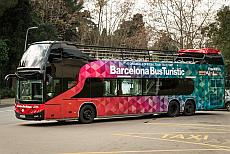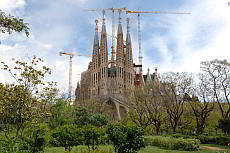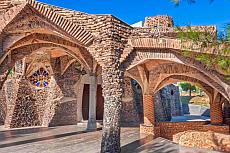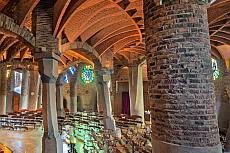Colònia Güell - Crypt Gaudí
Colònia Güell, an industrial complex of modernism, the crypt is Gaudí's experiment
The Colònia Güell is a former industrial complex from the time of modernism. The industrial plant was named after its owner Eusebi Güell.
Content of this page
In addition to the factory buildings, the Colònia Güell also includes a settlement for workers and their families. A special highlight of the Colònia is undoubtedly the crypt of Antoni Gaudí, which was appointed World Heritage Site in 2005.
The crypt of Gaudí, on which Gaudí should have built an imposing church, is extremely worth seeing with its architecture: Antoni Gaudí has already found many architectural solutions that he had later used in the construction of the Sagrada Familia.
Tickets for visiting Gaudís crypt
- Discover Gaudí's best-kept treasure, the crypt, and see the textile village of Colònia Güell from the 19th century
- Learn a lot of interesting knowledge through the audio guide, for example how the crypt served as an inspiration for the Sagrada Familia
- Visit a UNESCO World Heritage site that fits completely into the hills of the surroundings - an absolute novelty at that time
- Admission for the Gaudí's crypt and the Colònia Güell
- Audio guide
- Discover one of Gaudí's best-kept treasures, the crypt, and the Colònia Güell, a textile colony from the late 19th century
- Find out all the details about the crypt with your travel guide - did you know that you served as inspiration for the Sagrada Familia?
- Enter a UNESCO World Heritage Site and let yourself be enchanted by the atmosphere and the stories of a legendary industrial colony
- Guided tour in Spanish and Catalan (Sat. + Sun.)
- Entry in Gaudí's crypt and the Colònia Güell
The Colònia, the crypt and the information center
If you visit the Colònia Güell, the crypt Gaudí and the information center, you will learn a lot about life in the industrial "colonies" at the time of modernism.
Crypt Gaudí
Colònia Güell
The Colònia Güell is an important artistic and historical heritage. The path between the buildings is so fascinating because of its charm and calm. You can literally feel the atmosphere of the industrial colony of the modernism at the end of the 19th century.
As a visitor, you can walk around the buildings that have been created by modernist architects and where you can recognize the characteristics of this architectural movement: brick walls as the classic construction in cities and use of modern materials such as steel and trencadis ceramics.
Crypt Gaudí
If you visit the crypt created by Antoni Gaudí, you will probably have the same thoughts as we do: "Too bad that Gaudí has âânot finished this building". The brilliant architect is said to have said about the church that it would have been a monumental model of the Sagrada Famlia if it had been completed.
The crypt was Gaudí's experimental field for the construction of the Sagrada Famlia.
Gaudí created the nave of the crypt as a single RAM that does not require a button or support walls. This was made possible by crooked pillars and arches, which also led to the hyperbolic parabolic form of the surrounding walls.
The building is merged with the surroundings, the different levels of the ships and adapted to the hill, materials and colors resemble those of the surrounding vegetation at the time.
The applied architectural solutions of structural engineering, construction techniques, statics and shapes are original and surprisingly simple. Numerous examples of how Gaudí dominated applied art in terms of practical and decorative implementation.
The crypt was included in the UNESCO list of the World Heritage in 2005.
Information center
The visitor center is located in the former cooperative building of the Colònia Güell. The museum is quite exciting. It is devoted to the life of the workers and their families during the modernism from around 1890 to around 1910. It also shows the work of the Familia Güell, which, in contrast to most industrialists of the time, was also socially committed.
And of course the exhibition is also largely devoted to a large part of the crypt and its builder Antoni Gaudí. Particularly impressive is the exhibition with the help of which Gaudí determined the statics of sener buildings: he made a model of the columns and arches out of chains, turned it and hung it on the ceiling. He determined different loads by hung on the chains. So he was able to quickly determine that the pressure was distributed on the individual structures.
Directions to Colònia Güell
The journey by train from the FGC (Ferrocarrils de la Generalitat de Catalunya) from the Plaça Espanya is very easy. The journey lasts about 20-30 minutes.
- Independent return trip by train from the FGC from Plaça Espanya. Lines S3, S4, S8 and S9; Direction: Colonia Güell.
- At the "Colonia Güell" station, cross the street. Blue footprints on the sidewalk show you the way to the Colònia Güel information center, from where you can watch the museum, start a tour through the Colonia and visit the crypt.
- The trains run with a tight clock, not to worry about departure times.
- Note: In contrast to earlier, Colònia Güel is now also in zone 1 of public transport. So you can travel with the Barcelona Card or the Hola BCN! Ticket for free.
- The Colònia Güell is located in "Santa Coloma de Cervelló", about 15 km from Barcelona's city center. If you come by car, there are enough free parking spaces on the area.
History of Colònia Güell
The construction of the "Colònia Güell" workers' settlement began in 1890 on the initiative of the entrepreneur Eusebi Güell. His property "Can Soler de la Torre" was in the municipal area of Santa Coloma de Cervelló, in the current district of Baix Llobregat.
At that time, it began to keep the growing social conflicts away in the cities, to build industrial areas in which the workers lived directly with their families. The houses of the workers were to be created on the same property next to the factory and with this a settlement core with its own social and economic life supervised by the company. The Colonias, industrial colonies, were therefore independent, isolated villages.
In contrast to the vast majority of industrial settlements in Catalonia, Eusebi Güell tried to introduce social improvements for workers and worked as cultural patrons. He equipped the Colonia Güell with cultural and religious institutions and commissioned various architects to build new buildings in the style of modernism. A unique example of this is the church of Antoni Gaudí.
The bricklayers also left certificates of their talent on numerous buildings, as can be seen particularly on the diverse cornices and facade details.
The workers' settlements were intended as a social and economic organization with the main purpose of industrial production. Men and women of the settlement spent the majority of their time in the factory, which guaranteed a regular income for them in a time of economic uncertainty.
Over the years, the settlement was also recorded by the trade union movement and the demands of the workers. At the beginning of the Spanish Civil War, the factory was collectivated and managed by the workers. After the end of the war, she was refunded to the Güell family, which she sold to the Bertrand Y Serra family in 1945. In the following years, industrial production continued and the settlement kept her from the town of Santa Coloma de Cervelló largely separate life. However, the population of the place grew continuously and exceeded those of the workers' settlement in the 1960s.
The Colònia Güell, on the other hand, was spared the uncontrolled urban growth of the 60s and 70s. It practically remained a compact settlement, the main purpose of which was in industrial production. During the crisis of the textile industry, however, the factory was closed in 1973, an event that led to significant upheavals. The possession was sold during the following years: the work in small parts to various companies, the houses to their residents and the facilities and surrounding properties at public institutions.
Why visiting the Colònia Güell
With the crypt gaudí you can see a preliminary work by the Sagrada Familia. Here he tried techniques and styles that were later perfected in the Sagrada Familia. If you are interested in Gaudí's history, you should definitely visit the crypt.
The entire Colònia facility is also interesting, it stands for innovation and progress for the workers at that time. It is very nice today to walk between the buildings and factories and to let the modernism's atmosphere work. In Barcelona you will experience the modernism of bourgeosia, here the simple people.
While walking through the Colonia Güell you can take a break in one of the cafes and restaurants.
Book your admission and guided tours here
(Click on the product images to display prices and availability)
Important information
Surroundings
Find Hotels nearby
Address
Carrer Claudi Güell, 6
Arrival
Metro: FGC: S3, S4, S8, S9 (Colònia Güell)
Parking nearby
Opening times
On weekdays: 10.00 - 17.00
Sat., Sun., holidays: 10.00 - 15.00
Closed on: 1 Jan., 6 Jan., 25/26 Dec.
Admission
Admission + Audiogude: €10.00
Reduced (students, under 10 years, +65): €7.5
Guided tour cript and Colonia Güell + admission: €13.00 (reduced €11.00)
Notes on visiting Colònia Güell
You should take at least 5-6 hours for arrival, visiting the info center and the crypt Gaudi and enen walk through the colony. There are several bars and restaurants for a break.






